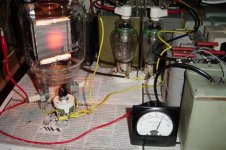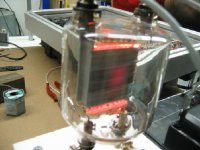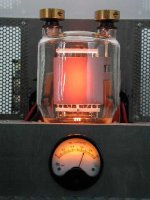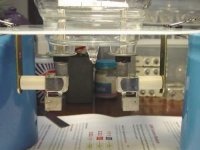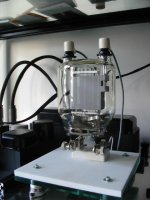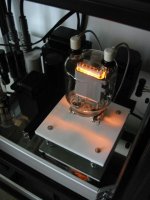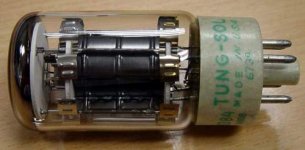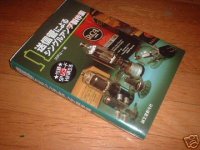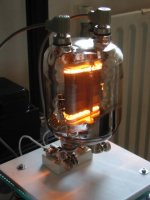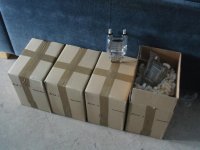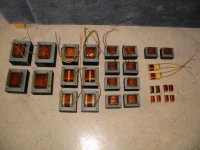red spot on plate...
Hi Bas and Tubeman,
sorry fo not answering faster......i'm not always on-line.
Bas: the transformers are (almost all) made by Heart. The owner is Rik stoet. Yes.....he started with import Chinese stuff. Nowadays he has his own transformer-winder. Not surprisingly for his father was owner of a transformer company. as was his grandfather.....He is the first to step over to audio-gear.
Look onder www.tubes4all.nl and www.heartaudio.nl and you'll see that there websites are really old. There isn't even a notification of there moving from Den Haag to Zoetermeer.
Doesn't matter.....their transformers are really nice !
Tubeman: No worries about the chery red plate. Currently i'm using the 833 with 1000 V as B+ and i can see a nice cherry red colour in the middle of the plate.
Look at the RCA TT-5 manual: "....plate shows an orange-red colour...." But that's on max specs.
I'll attach a picture of aa 833A in my amp. And i have somewhere a picture of a 833C wich is really orange !!! Remeber: that's a massive carbon-plate......
Reinout
Hi Bas and Tubeman,
sorry fo not answering faster......i'm not always on-line.
Bas: the transformers are (almost all) made by Heart. The owner is Rik stoet. Yes.....he started with import Chinese stuff. Nowadays he has his own transformer-winder. Not surprisingly for his father was owner of a transformer company. as was his grandfather.....He is the first to step over to audio-gear.
Look onder www.tubes4all.nl and www.heartaudio.nl and you'll see that there websites are really old. There isn't even a notification of there moving from Den Haag to Zoetermeer.
Doesn't matter.....their transformers are really nice !
Tubeman: No worries about the chery red plate. Currently i'm using the 833 with 1000 V as B+ and i can see a nice cherry red colour in the middle of the plate.
Look at the RCA TT-5 manual: "....plate shows an orange-red colour...." But that's on max specs.
I'll attach a picture of aa 833A in my amp. And i have somewhere a picture of a 833C wich is really orange !!! Remeber: that's a massive carbon-plate......
Reinout
Attachments
833 socket caution
Hi Tubeman,
great to see more people working with the 833. It's a nice sounding tube !
I do have to warn you about the tube sockets. The 833 can be very very hot.
When i first want to build the amplifier i just wanted to fix the tube socket on a glass plate (10 mm). Just for the looks (and doubles nice as an isolator). But the tube is really hot, not to mention the filament pins themselfes. The glass plate was continiously strongly heated at the same spot and i was afraid it was going to crack. So i had to fix a teflonplate in between the socket and the glass. The teflon is white (reflects heat) and disperses the heat to a larger surface.
Very usable stuff: teflon. It can take a real heat-pounding. Can your epoxy also suffer hard before break-down ? If it melts....you're in for a nice firework.
Also remember that the filament gobbles away 10V / 10 A. And there is a 20 Ampere inrush during warm-up. That is like a car battery with all well deserved warnings. So no flimsy connectors, lightweight hookup wire, crocodile clips and so on.
Foto included.
Keep us all informed about your progress ?
With regards,
Reinout
Hi Tubeman,
great to see more people working with the 833. It's a nice sounding tube !
I do have to warn you about the tube sockets. The 833 can be very very hot.
When i first want to build the amplifier i just wanted to fix the tube socket on a glass plate (10 mm). Just for the looks (and doubles nice as an isolator). But the tube is really hot, not to mention the filament pins themselfes. The glass plate was continiously strongly heated at the same spot and i was afraid it was going to crack. So i had to fix a teflonplate in between the socket and the glass. The teflon is white (reflects heat) and disperses the heat to a larger surface.
Very usable stuff: teflon. It can take a real heat-pounding. Can your epoxy also suffer hard before break-down ? If it melts....you're in for a nice firework.
Also remember that the filament gobbles away 10V / 10 A. And there is a 20 Ampere inrush during warm-up. That is like a car battery with all well deserved warnings. So no flimsy connectors, lightweight hookup wire, crocodile clips and so on.
Foto included.
Keep us all informed about your progress ?
With regards,
Reinout
Attachments
Thank you !
Thank you ! Reinout for your help.
Maybe I change Epoxy to Teflon plate but in Thailand the Teflon are very expensive than Epoxy. And the original socket for 833A can't find in Thailand .
Can you tell me about the ratio of interstate transformer (from your 300B to 833A ). Is it Stepdown IT ? Because I have a pair of Lundahl LL1671/50mA interstate and I should connecting it to 4:1 Stepdown for more current to drive 833A-grid and not require to Stepup because the 833A are Hi-mu tube. Can you comment it ?
Thank you ! Reinout for your help.
Maybe I change Epoxy to Teflon plate but in Thailand the Teflon are very expensive than Epoxy. And the original socket for 833A can't find in Thailand .
Can you tell me about the ratio of interstate transformer (from your 300B to 833A ). Is it Stepdown IT ? Because I have a pair of Lundahl LL1671/50mA interstate and I should connecting it to 4:1 Stepdown for more current to drive 833A-grid and not require to Stepup because the 833A are Hi-mu tube. Can you comment it ?
teflon + interstage
Hi Tubeman,
teflon is just as expensive in Europe. It is simply a great material to work with: perfect isolator, reasonable sturdy, machinable, heat resistant. And with a price to match.......
Sorry, this stuff is not cheap. But i've found no real substitue. And when you're stepping into the use of these tubes i don't skimp on safety !
Your step down ratio for the 300B-833-IT is exactly what i use: 4:1. It works nicely and makes use of the high mu characteristics of the 833.
And how you "fire up" a 300B: absolutely your own choice. And there are more than enough choices to pick from.....
What are you intending to use ?
Reinout
(picture of 833C attached)(currently i'm listening to different 833's.....fun !)
Hi Tubeman,
teflon is just as expensive in Europe. It is simply a great material to work with: perfect isolator, reasonable sturdy, machinable, heat resistant. And with a price to match.......
Sorry, this stuff is not cheap. But i've found no real substitue. And when you're stepping into the use of these tubes i don't skimp on safety !
Your step down ratio for the 300B-833-IT is exactly what i use: 4:1. It works nicely and makes use of the high mu characteristics of the 833.
And how you "fire up" a 300B: absolutely your own choice. And there are more than enough choices to pick from.....
What are you intending to use ?
Reinout
(picture of 833C attached)(currently i'm listening to different 833's.....fun !)
Attachments
Driver state
Thank you ! Reinout
I think the 300B is the best for drive 833A but 300B I haven't and very expensive too.and I have many tube NO. KT66 , 6L6GC or 6384 (premium grade of 6AR6)
Can I use it ? Maybe I use pentode connect to triode mode tube in 6384 or 6L6GC.And I"m not sure it can drive enough . If I need power output 50-70 w in SE
I have five choice in this.
1) 6EM7 hi-mu direct couple to 6EM7 lo-mu - interstate 4:1 to 833A (maybe low power)
2) 6SN7-1st direct couple to 6SN7-2nd - Cap coupling to 6384 or 6L6 - interstate 4:1 to 833A
3) 6C45pi - Cap coupling to 6384 or 6L6 - interstate 4:1 to 833A
4) 6SL7 - Cap coupling to 6384 or 6L6 - interstate 4:1 to 833A
5) 6SL7 - direct couple to 6BL7 or 6BX7 - interstate 4:1 to 833A (maybe low power)
Comment it plese!
Thank you !
tubeman.
Thank you ! Reinout
I think the 300B is the best for drive 833A but 300B I haven't and very expensive too.and I have many tube NO. KT66 , 6L6GC or 6384 (premium grade of 6AR6)
Can I use it ? Maybe I use pentode connect to triode mode tube in 6384 or 6L6GC.And I"m not sure it can drive enough . If I need power output 50-70 w in SE
I have five choice in this.
1) 6EM7 hi-mu direct couple to 6EM7 lo-mu - interstate 4:1 to 833A (maybe low power)
2) 6SN7-1st direct couple to 6SN7-2nd - Cap coupling to 6384 or 6L6 - interstate 4:1 to 833A
3) 6C45pi - Cap coupling to 6384 or 6L6 - interstate 4:1 to 833A
4) 6SL7 - Cap coupling to 6384 or 6L6 - interstate 4:1 to 833A
5) 6SL7 - direct couple to 6BL7 or 6BX7 - interstate 4:1 to 833A (maybe low power)
Comment it plese!
Thank you !
tubeman.
833 possibilities
Hi Tubeman,
lots of possibilities. If i'm looking at your proposals Shisido's tube book "audio amplifiers with transmitting tubes" comes into my mind. On the first page of this thread you'll find a message by Kuei Yang Wang with a link to Ronald Koridan's story of the Shisido-805-amplifier. Please follow that link; you'll automatically find schematics of the amp and pro's/con's.
Ronald is going to build a 833-amp based on the same circuit, but with a triode strapped KT-88 as a driver. It should be comparable with the Wavac HE-833. And i'm looking forward to hearing it (he lives in The Netherlands also).
300B expensive ?. To be honest....the last couple of years the audio community is simply overwhelmed by the availability of 300B's. Not all good and perfect.....but there is choice ! And the prices have gone down considerably because of that choice. Still it is quite some money. But what price do you have to pay for a high quality KT-88 or KT-66 ? NOS ? Those are not cheap either ! And there is less choice.......
But if i understand it you have new old stock KT-66: should be very interesting.
Anyway, you can use a good triode with a stepdown IT for lowering the impendance. Or you can use a triode strapped penthode. It's your choice. Is it better....i don't know. I know it's different. The driver-system of a 833 needs to be powerfull enough with enough swing. Both systems are perfectly usable; taste ?
Your 6EM7 options is likely to be underpowered.
6L6's have been tried in comperable schematics/amps and work good. See also Ronald Koridan's story which even includes the working schematic. As KT-66/88's will do (not heared.....but should be no problem).
I'm not familiar with the 6AR6/6384.
Allmost all proposals you mention are penthode-based: get that Shisido-book for he really likes to use triode-strapped penthodes as drivers !!!!!!!! (i'll enclose a picture of the book. No schematics due to copyright.....).
I have that book for some time now and although it is in Japanese (which i can not read) the schematics are self-explaining. Recommended !
The second/third/fourth option you have are basically driver-wise all the same. What you chance is only the input-tube.
The 6C45 is a very nice tube. I've built a phono-amp based on that tube which much succes (personal opinion of course). Be carefull: these tubes have different characteristics all over the place. You have to buy quite a lot to get nice pairs (note: they are all OK.....just different) which is necessary with a mu of 52.
The 6SN7/6SL7 do have a huge advantage for having so many options with tube rolling. There is only one brand 6C45; but which company did NOT produce the 6SN7 ? So when you use the 6SN7 or 6SL7 and the basics of your amp are OK you can tube swap 6SN7GT/GTA/GTB/W/WGT/WGTA/GTY/etc by whatever brand you can lay your hands on in order to find a good sounding combination.
You sended a picture of a 6384-tube ? Maybe there is something wrong with my computer for it does not show up ?
Reinout
Hi Tubeman,
lots of possibilities. If i'm looking at your proposals Shisido's tube book "audio amplifiers with transmitting tubes" comes into my mind. On the first page of this thread you'll find a message by Kuei Yang Wang with a link to Ronald Koridan's story of the Shisido-805-amplifier. Please follow that link; you'll automatically find schematics of the amp and pro's/con's.
Ronald is going to build a 833-amp based on the same circuit, but with a triode strapped KT-88 as a driver. It should be comparable with the Wavac HE-833. And i'm looking forward to hearing it (he lives in The Netherlands also).
300B expensive ?. To be honest....the last couple of years the audio community is simply overwhelmed by the availability of 300B's. Not all good and perfect.....but there is choice ! And the prices have gone down considerably because of that choice. Still it is quite some money. But what price do you have to pay for a high quality KT-88 or KT-66 ? NOS ? Those are not cheap either ! And there is less choice.......
But if i understand it you have new old stock KT-66: should be very interesting.
Anyway, you can use a good triode with a stepdown IT for lowering the impendance. Or you can use a triode strapped penthode. It's your choice. Is it better....i don't know. I know it's different. The driver-system of a 833 needs to be powerfull enough with enough swing. Both systems are perfectly usable; taste ?
Your 6EM7 options is likely to be underpowered.
6L6's have been tried in comperable schematics/amps and work good. See also Ronald Koridan's story which even includes the working schematic. As KT-66/88's will do (not heared.....but should be no problem).
I'm not familiar with the 6AR6/6384.
Allmost all proposals you mention are penthode-based: get that Shisido-book for he really likes to use triode-strapped penthodes as drivers !!!!!!!! (i'll enclose a picture of the book. No schematics due to copyright.....).
I have that book for some time now and although it is in Japanese (which i can not read) the schematics are self-explaining. Recommended !
The second/third/fourth option you have are basically driver-wise all the same. What you chance is only the input-tube.
The 6C45 is a very nice tube. I've built a phono-amp based on that tube which much succes (personal opinion of course). Be carefull: these tubes have different characteristics all over the place. You have to buy quite a lot to get nice pairs (note: they are all OK.....just different) which is necessary with a mu of 52.
The 6SN7/6SL7 do have a huge advantage for having so many options with tube rolling. There is only one brand 6C45; but which company did NOT produce the 6SN7 ? So when you use the 6SN7 or 6SL7 and the basics of your amp are OK you can tube swap 6SN7GT/GTA/GTB/W/WGT/WGTA/GTY/etc by whatever brand you can lay your hands on in order to find a good sounding combination.
You sended a picture of a 6384-tube ? Maybe there is something wrong with my computer for it does not show up ?
Reinout
Attachments
protos-reply
Hi Protos,
the amps were finished 2 months ago. So to be honest.....still burning in. Not surprisingly with the amount of hardware used.
What strikes everybody immediately is the "effortless" of the 833-amp. It's so naturall, no forcing whatsoever.
The first months there was a lack of serious bass, but that is past tense. Nowadays there is plenty of bass; my neighbours noticed the chance......
I still have a 300B-amp. Parallel push pull (so 4 x 300B's each channel). Yes: that had more grunt in the lowest registers. But it is forced !!!!!!! It is not fluent as the 833-amp. And i think with time passing by the 833-amp will pass the former amps on bass-output. The quality of the bass is already better.
Currently i'm tube-swapping different 833's (got here NOS Tungsram's 833A, Penta 833C and Polyaron GU-48's) and there are really differences. Add that to the availability of my driver (300B) and input tube (6SN7) and i still have a lot of listening sessions to look forward to.
I'm part of a group of hifi-addicts who share knowledge / equipment / ideas / parts / etc and regularly we have an "audio-gathering" (absolutely incomprehensible for outsiders....read girlfriends/wives) where we use each others hifi-pojects. Of course i'm not moving the 833-amps (280 kg in total....) so the orhers bring in there stuff. Or we're going to listen at their places. So i have the opportunity to look/listen to a lot of really different projects.
Amplifiers: the 833-amps have the natural-sounding quality of SE combined with the bass of PP. And of course i'll receive a lot of comment on this simple sentence. I know: there are lots of SE with a huge bass output/quality. And there are PP amps with natural-sounding qualities. It's just difficult to explain and i do not want to offend any one.
Price-wise: a lot of the components i've found on Ebay. Really: without it i had to pay a lot more.
- nearly all the transformers were sourced from the Netherlands based firm "Heart" / Rik Stoet (so also earlier in this thread);
- tubes: long live internet. And with the Euro-Dollar ratio it's very nice importing stuff;
- resistors, capacitors, connectors, pots, switches, fuses......EBAY !
- i've found a producer of farming equipment willing to do the laser cutting of the top- and down plates of the amp. They're made out of 4 mm stainless steel. Not very easy to handdrill that thickness. Aluminium was not really an option because of the transformer weight.... Plates out of aluminium would not stay straight.
- the outer rims of the amplifiers and power supply are made by a producer of assembly lines / conveyor belts.
The transformers were the largest attack on my wallet. But is was lucky enough to have quite some "iron" already available from former projects.
For years i've collected / gathered components (through Ebay) for other projects. And if i could use them now: why not.
How can i give a total price ???
Included a picture the current used GU-48 (Russian equivalent of the 833)
Reinout
Hi Protos,
the amps were finished 2 months ago. So to be honest.....still burning in. Not surprisingly with the amount of hardware used.
What strikes everybody immediately is the "effortless" of the 833-amp. It's so naturall, no forcing whatsoever.
The first months there was a lack of serious bass, but that is past tense. Nowadays there is plenty of bass; my neighbours noticed the chance......
I still have a 300B-amp. Parallel push pull (so 4 x 300B's each channel). Yes: that had more grunt in the lowest registers. But it is forced !!!!!!! It is not fluent as the 833-amp. And i think with time passing by the 833-amp will pass the former amps on bass-output. The quality of the bass is already better.
Currently i'm tube-swapping different 833's (got here NOS Tungsram's 833A, Penta 833C and Polyaron GU-48's) and there are really differences. Add that to the availability of my driver (300B) and input tube (6SN7) and i still have a lot of listening sessions to look forward to.
I'm part of a group of hifi-addicts who share knowledge / equipment / ideas / parts / etc and regularly we have an "audio-gathering" (absolutely incomprehensible for outsiders....read girlfriends/wives) where we use each others hifi-pojects. Of course i'm not moving the 833-amps (280 kg in total....) so the orhers bring in there stuff. Or we're going to listen at their places. So i have the opportunity to look/listen to a lot of really different projects.
Amplifiers: the 833-amps have the natural-sounding quality of SE combined with the bass of PP. And of course i'll receive a lot of comment on this simple sentence. I know: there are lots of SE with a huge bass output/quality. And there are PP amps with natural-sounding qualities. It's just difficult to explain and i do not want to offend any one.
Price-wise: a lot of the components i've found on Ebay. Really: without it i had to pay a lot more.
- nearly all the transformers were sourced from the Netherlands based firm "Heart" / Rik Stoet (so also earlier in this thread);
- tubes: long live internet. And with the Euro-Dollar ratio it's very nice importing stuff;
- resistors, capacitors, connectors, pots, switches, fuses......EBAY !
- i've found a producer of farming equipment willing to do the laser cutting of the top- and down plates of the amp. They're made out of 4 mm stainless steel. Not very easy to handdrill that thickness. Aluminium was not really an option because of the transformer weight.... Plates out of aluminium would not stay straight.
- the outer rims of the amplifiers and power supply are made by a producer of assembly lines / conveyor belts.
The transformers were the largest attack on my wallet. But is was lucky enough to have quite some "iron" already available from former projects.
For years i've collected / gathered components (through Ebay) for other projects. And if i could use them now: why not.
How can i give a total price ???
Included a picture the current used GU-48 (Russian equivalent of the 833)
Reinout
Attachments
833 tubes
Hello NickC and Tubeman,
this is going to be a very long and interesting thread. I hope it will continue !
Currently i've got 3 variants of the 833:
- Tungsram 833A
- Penta 833C
- Polyaron GU-48
The Tungsram 833A is a direct copy of the original American tube. Just check any older tube manual (Amperex, RCA) and you'll see that this is e very good example of the 833A.
Soundwise it is quite neutral. Not boring !!!! It simply does not have a single strong or weak point which is really obvious. And i think that is a strong point in it's own right ?
There is enough bass-output and the high's are without sharp edges. Very listenable.
The Penta 833C is a totally different tube. Not surprisingly with a massive carbon anode. A beast with a highly increased max plate dissipation (if you need it....) There is even a 833D.....but that gobbles away even more filament-current. Already the 833C is massive, the anode system is just like the standard 833A fixed to one of the topconnectors. And due to the weight is it not perfectly aligned inside the glass enveloppe.
Although massive in appearance this is quite a fragile tube. The first shipment of 4 from the USA to Europe all had broken filaments. The next shipment came in extremely well packed (shipping was already 100 $) and was OK.
Soundwise: a tadd more bass. Not deeper than the Tungsram; fuller would be a more appropriate discription. You'll lose some of the extreme detail in 'highs" of the Tungsram. A taste-difference; not quality difference.
The only quality issue i have with the 833C or Penta is the fragility of the filaments.
The Polyaron GU-48 is a really sturdy and well build Russian tube. This will survive the next World War ! No anode hanging from one side of the top. This tube is build-up from below with 2 solid pillars and a massive ceramic base. Simply sturdy. In fact it looks like a giant 300B. Is there a snatch: YES. And a huge one: all connections are off-spec. The top-connections are a millimeter to small (so the topcaps wobble) and the filament-connectors are 2 millimeters to large ! I had to use a angle-grinder to make them fit. During this "operation" the tubes received a huge mechanical hammering.....without any problems. That underlines the mechanical quality. But why did they not stick to the specs ?
Soundwise: bass !!! But you here you lose real high-frequency quality. Not in extension; but in freshness / details.
Sources:
Penta 833C: www.pentalaboratories.com (96$)
GU-48: www.tubes.ru (65$)
Tungsram 833A: michael@halfin.com at www.halfin.com
Currently the Euro-Dollar ratio is very interesting to import stuff from the USA or Russia (they calculate everything in Dollars...and dealing with them was reasonable easy). Downside: huge import tax AND high shipping costs. Besides that there is the guarantee-issue. When troubles occur....send the tubes back transatlantic or back to Russia ? You can imagine that the first Penta shipment was a huge dissapointment.
The Tungsram-source is Belgium-based. So a bit more closeby for me. Price-wise quite the same but combined with the importtax and shipping costs definately cheaper (for me). Only later i found out that i could order the 833C also through him. Next time.
How are you're experiences with sourcing this tube. Please do send that info to me for i'm looking for all 833 manufacturers (RCA, GE, Amperex, etc) and simply ran into "no" wherever i asked for 833's from same batch/year/production cycle. Yes, there are a lot of tube vendors who have singles etc.
But from Polyaron i received 4 tubes of same productionDAY;
And from Penta i received 4 tubes with very close tube numbers (even 2 succeeding);
And from Halfin i received 8 tubes with close numbers and definately the same batch.
Looking forward to your reply,
Reinout
(picture of my 8 Tungsram "goldmine")
Hello NickC and Tubeman,
this is going to be a very long and interesting thread. I hope it will continue !
Currently i've got 3 variants of the 833:
- Tungsram 833A
- Penta 833C
- Polyaron GU-48
The Tungsram 833A is a direct copy of the original American tube. Just check any older tube manual (Amperex, RCA) and you'll see that this is e very good example of the 833A.
Soundwise it is quite neutral. Not boring !!!! It simply does not have a single strong or weak point which is really obvious. And i think that is a strong point in it's own right ?
There is enough bass-output and the high's are without sharp edges. Very listenable.
The Penta 833C is a totally different tube. Not surprisingly with a massive carbon anode. A beast with a highly increased max plate dissipation (if you need it....) There is even a 833D.....but that gobbles away even more filament-current. Already the 833C is massive, the anode system is just like the standard 833A fixed to one of the topconnectors. And due to the weight is it not perfectly aligned inside the glass enveloppe.
Although massive in appearance this is quite a fragile tube. The first shipment of 4 from the USA to Europe all had broken filaments. The next shipment came in extremely well packed (shipping was already 100 $) and was OK.
Soundwise: a tadd more bass. Not deeper than the Tungsram; fuller would be a more appropriate discription. You'll lose some of the extreme detail in 'highs" of the Tungsram. A taste-difference; not quality difference.
The only quality issue i have with the 833C or Penta is the fragility of the filaments.
The Polyaron GU-48 is a really sturdy and well build Russian tube. This will survive the next World War ! No anode hanging from one side of the top. This tube is build-up from below with 2 solid pillars and a massive ceramic base. Simply sturdy. In fact it looks like a giant 300B. Is there a snatch: YES. And a huge one: all connections are off-spec. The top-connections are a millimeter to small (so the topcaps wobble) and the filament-connectors are 2 millimeters to large ! I had to use a angle-grinder to make them fit. During this "operation" the tubes received a huge mechanical hammering.....without any problems. That underlines the mechanical quality. But why did they not stick to the specs ?
Soundwise: bass !!! But you here you lose real high-frequency quality. Not in extension; but in freshness / details.
Sources:
Penta 833C: www.pentalaboratories.com (96$)
GU-48: www.tubes.ru (65$)
Tungsram 833A: michael@halfin.com at www.halfin.com
Currently the Euro-Dollar ratio is very interesting to import stuff from the USA or Russia (they calculate everything in Dollars...and dealing with them was reasonable easy). Downside: huge import tax AND high shipping costs. Besides that there is the guarantee-issue. When troubles occur....send the tubes back transatlantic or back to Russia ? You can imagine that the first Penta shipment was a huge dissapointment.
The Tungsram-source is Belgium-based. So a bit more closeby for me. Price-wise quite the same but combined with the importtax and shipping costs definately cheaper (for me). Only later i found out that i could order the 833C also through him. Next time.
How are you're experiences with sourcing this tube. Please do send that info to me for i'm looking for all 833 manufacturers (RCA, GE, Amperex, etc) and simply ran into "no" wherever i asked for 833's from same batch/year/production cycle. Yes, there are a lot of tube vendors who have singles etc.
But from Polyaron i received 4 tubes of same productionDAY;
And from Penta i received 4 tubes with very close tube numbers (even 2 succeeding);
And from Halfin i received 8 tubes with close numbers and definately the same batch.
Looking forward to your reply,
Reinout
(picture of my 8 Tungsram "goldmine")
Attachments
Hi,
Guys,
If there's sufficient interest, why not group your purchases of 833s?
As Michael Wiams of Halfin is a close friend of mine I'm sure I can negociate prices with him if you can raise sufficient quantities.
If necessary I can even check the tubes at their premises for you.
Just let me know in advance and I'll see what I can do.
Cheers,
Guys,
If there's sufficient interest, why not group your purchases of 833s?
As Michael Wiams of Halfin is a close friend of mine I'm sure I can negociate prices with him if you can raise sufficient quantities.
If necessary I can even check the tubes at their premises for you.
Just let me know in advance and I'll see what I can do.
Cheers,
hmmm, this tube seems more and more interesting to me.
My current amps are gm70 based, and the 833 seems interesting as a next step. (high voltage, and high current filament makes for quite a challenge)
I could be interested for a group buy later in the year, sourcing parts for this kind of amps always takes a while.
Reinout, what's the operating point you're using? zero-grid biasing? what's the output transformer? 5kOhm, 150mA?
Do you use ac filaments on that 833?
thanks,
Filip.
My current amps are gm70 based, and the 833 seems interesting as a next step. (high voltage, and high current filament makes for quite a challenge)
I could be interested for a group buy later in the year, sourcing parts for this kind of amps always takes a while.
Reinout, what's the operating point you're using? zero-grid biasing? what's the output transformer? 5kOhm, 150mA?
Do you use ac filaments on that 833?
thanks,
Filip.
833 continue
Hi Filip, Tubeman, fdegrove and NickC,
yes, the 833 IS a very interesting tube. Great sound, good looks, and you're underway with a real project for some time ! And not everybody is using them. Not that 211's and 845's are boring (heard real good amps with them) ....but there is so much more. Like your own GM70's.
For such a huge tube i think the prices are very decent. Remember that these tubes are almost all very sturdy in design; they should last for quite some time. Originally they're made for big transmitters (and still being used there). For that kind of application you don't need whimpy stuff. They're build for 24/24 service !
About operating points: my B+ powersupply has the choice of 1000 ~ 1250 ~ 1500 VDC (several transformer taps). On this moment i'm running on 1000 VDC (and not really finding it necessary to switch to higher VDCs). At that voltage the tube likes to see 200 mA-ish. Going higher with the VDC the mA's drop to lower ma's when you're going to negative bias. Just follow the curves. Speaking of curves: yes, it's a zero grid-bias.
My output transformrs are 5K. When i was doing the theory on these amps i had the choice of going to real high voltage (3 kV-ish) or staying at more tolerable voltages (current 1 ~ 1,5 KV). At the 3 kV the 833 want to see something of around 15 K and at 2 kV 10 K-ish. (data sourced through internet)
Not impossible to make these transformers but remember that the ratio from 18 K to 4~8 ohms means a lot of copperwire turns. So or a huge transformer or a thin wire. A thin wire is out of the question. 3 kV AND 100 mA means a lot of heat.....loss
So a huge hunk of iron. Add that to the needed insulator between the primaries and the secondaries of the transformer and that transformer is not manageble anymore.
I was looking for a lower ratio with quite thick wire (in order to have low loss). And i could use less exotic insulator material.
It became a 5 k transformer to be used at lower voltages.
Filament: i do have to admit: i never heared the difference between AC / DC on the 833.
MY theory: the lower the voltage on filaments, the easier to avoid hum. It is perfectly possible with a 2A3 (2,5 V) as with the older European standard of 4 V (PX4/25, AD1, etc). The 300B with 5 volts is pushing, but still possible. But the 10 v / 10 A of a 833 ??? I started with a DC based schematic ....just to avoid problems. However it should be possble as the tube manual give as a filament requirement: 10 V AC or DC.
If you're planning to go AC please do share your experiences with us ? From my side i can only say that the DC-variant is SILENT.
About your comment on sourcing the components for these amps: you are quite right. It took me a long time to get all the goodies together.
Included a picture of some of the transformers used in this project. The 5 k opt's are the ones with 2 yellow bands (middle lower part of picture). Remember that these are already EI126 ! (126 x 106 mm)
Reinout
Hi Filip, Tubeman, fdegrove and NickC,
yes, the 833 IS a very interesting tube. Great sound, good looks, and you're underway with a real project for some time ! And not everybody is using them. Not that 211's and 845's are boring (heard real good amps with them) ....but there is so much more. Like your own GM70's.
For such a huge tube i think the prices are very decent. Remember that these tubes are almost all very sturdy in design; they should last for quite some time. Originally they're made for big transmitters (and still being used there). For that kind of application you don't need whimpy stuff. They're build for 24/24 service !
About operating points: my B+ powersupply has the choice of 1000 ~ 1250 ~ 1500 VDC (several transformer taps). On this moment i'm running on 1000 VDC (and not really finding it necessary to switch to higher VDCs). At that voltage the tube likes to see 200 mA-ish. Going higher with the VDC the mA's drop to lower ma's when you're going to negative bias. Just follow the curves. Speaking of curves: yes, it's a zero grid-bias.
My output transformrs are 5K. When i was doing the theory on these amps i had the choice of going to real high voltage (3 kV-ish) or staying at more tolerable voltages (current 1 ~ 1,5 KV). At the 3 kV the 833 want to see something of around 15 K and at 2 kV 10 K-ish. (data sourced through internet)
Not impossible to make these transformers but remember that the ratio from 18 K to 4~8 ohms means a lot of copperwire turns. So or a huge transformer or a thin wire. A thin wire is out of the question. 3 kV AND 100 mA means a lot of heat.....loss
So a huge hunk of iron. Add that to the needed insulator between the primaries and the secondaries of the transformer and that transformer is not manageble anymore.
I was looking for a lower ratio with quite thick wire (in order to have low loss). And i could use less exotic insulator material.
It became a 5 k transformer to be used at lower voltages.
Filament: i do have to admit: i never heared the difference between AC / DC on the 833.
MY theory: the lower the voltage on filaments, the easier to avoid hum. It is perfectly possible with a 2A3 (2,5 V) as with the older European standard of 4 V (PX4/25, AD1, etc). The 300B with 5 volts is pushing, but still possible. But the 10 v / 10 A of a 833 ??? I started with a DC based schematic ....just to avoid problems. However it should be possble as the tube manual give as a filament requirement: 10 V AC or DC.
If you're planning to go AC please do share your experiences with us ? From my side i can only say that the DC-variant is SILENT.
About your comment on sourcing the components for these amps: you are quite right. It took me a long time to get all the goodies together.
Included a picture of some of the transformers used in this project. The 5 k opt's are the ones with 2 yellow bands (middle lower part of picture). Remember that these are already EI126 ! (126 x 106 mm)
Reinout
Attachments
- Home
- Amplifiers
- Tubes / Valves
- Where are the 833 amps?
